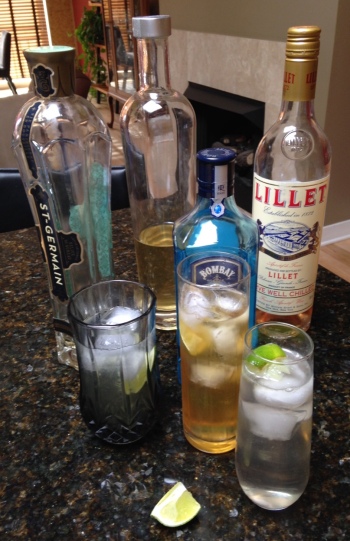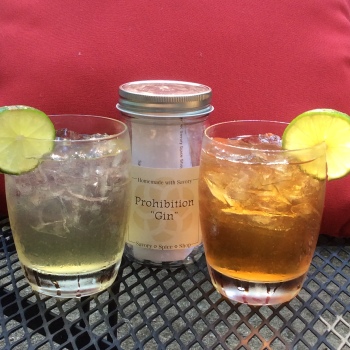 Proposed and Realized By: David
Proposed and Realized By: David
Also Realized By: Jonathan
“The gin and tonic,” Winston Churchill once said, “has saved more Englishmen’s lives, and minds, than all the doctors in the Empire.” He was alluding to the British East Indian Company’s invention of the concoction as a way of delivering quinine, which was believed to be an anti-malarial medicine. However, knowing Churchill, it’s possible he was talking about the self-medicating properties of gin.
I prefer the explanation of the drink’s prominence offered by Douglas Adams, the author of the Hitchhiker’s Guide to the Galaxy. Every planet has its own version of gin and tonic, all developed independently from one another and pronounced essentially the same. There’s something about the “G and T” (or “Gin Tonic” as it’s called in some countries) that demands invention. The drink was simply meant to be.
And, to support Adams’ theory, it turns out tonic doesn’t cure or prevent malaria because you’d have to drink too much of it (and keep drinking too much of it) to reach even the minimal level of quinine necessary to suppress the disease. Science has taught us something important about gin and tonic, however—rather than doubling the bitterness by combining its three main ingredients, the similarly shaped molecules glom onto each other to mitigate their bitterness. I take that discovery as further proof of Adam’s belief in the inevitability of gin and tonic.
So why would someone want to adulterate it, and why would we use this space (again) to encourage such an abomination?
I thought of a post devoted to the drink by itself debating the proper tonic water (I like Fever Tree or Q, by the way), the proper gin (more later), and the proper proportion of gin to tonic, but all that sounded fussy. Let me be that rare voice of political tolerance in our contentious age and state that all the people, Republicans and Democrats, should compose gin and tonics as they wish, according to their tastes.
As you’ll see, Jonathan was much subtler, thorough, and scientific in his pursuit of proper ingredients. For me, adulteration felt like a different sort of test—not can you mess-up a Gin and Tonic, but can you actually stay true to the Neo-platonic ideal of gin-and-tonic-ness while also introducing a variation that might actually enhance its essential nature?
My first experiment was to follow a basic formula:
1.5 ounces Gin
.5 ounces something else
3 ounces tonic water
the squeezed juice of one-eighth of a lime
Over the last three weeks, I’ve tried all sorts of things for that something else—Lillet Rose, St. Germaine, Pimm’s #1, Grand Marnier, Chambord, Maraschino Liqueur, and Benedictine—and most of the results were passable, but no gin and tonic. The best were the ones with a certain je ne sais quoi, the ones that elicited the comment, “What’s different about this?” Of the ingredients above, Pimm’s #1 and Lillet were the most successful that way. Maraschino was also subtle. The worst? Benedictine.
Like Jonathan, I also bought dried juniper berries and other spices (though not in a nifty kit) and steeped them in vodka to create my own gin… and added sumac to regular gin… and used varieties of gin available in my liquor cabinet… and foisted all these varieties on various people. Jonathan’s testers are clearly better than mine. Everyone around me is sick of gin and tonics, so sick that their most thoughtful comments were “That’s nice,” or “Yuck.”
But not me. I’ll just say one thing about my experimentation. Nothing really ruins a gin and tonic… until it makes it something else.
Here’s Jonathan’s Approach:
 Alternatives of the classic gin and tonic? How hard could it be – change the gin and change the tonic. Heck, go crazy and change the garnish. One look at my liquor cabinet illustrates the true challenge, though. I have Old Tom gin, London dry gin, Rangpur gin, botanical gin, barrel rested gin and, after a quick search for tonic syrups that resulted in the purchase of a pre-measured spice mix, my own homemade gin.
Alternatives of the classic gin and tonic? How hard could it be – change the gin and change the tonic. Heck, go crazy and change the garnish. One look at my liquor cabinet illustrates the true challenge, though. I have Old Tom gin, London dry gin, Rangpur gin, botanical gin, barrel rested gin and, after a quick search for tonic syrups that resulted in the purchase of a pre-measured spice mix, my own homemade gin.
You don’t need to go beyond tonic to understand the variations available. Quinine water, as we used to call it, ranges from classics like Seagrams, Canada Dry and Schweppes to a long list of high end and small batch sodas that grows each year. These include nationally available brands like Fever-Tree, Q and Fentimans to small batch soda versions found locally. There are also many syrups, I have used and love Jack Rudy’s, that can be mixed with club soda to make your own tonic water. Simple math made me realize I had to control the variables so I settled on premixed tonics.
The next question was gin. The classic uses London Dry and if the tonic was going to be dominant that made sense. As I noted, while searching unsuccessfully for new syrups I went into the Savory Spice Shop (a growing national franchise). They had a pre-packaged mix of spices to infuse vodka and make your own gin so that became another option. I also had a barrel rested gin, Cardinal, from nearby Kings Mountain N.C. and the gin style liqueur, Pimm’s No. 1, so I was set there too.
All that was left to do this right was to assemble taste testers and figure out ratios. My faithful panel was nice enough to gather for the task at hand and a forgotten shot glass made ratios approximate (I would guess it was 3:1 tonic to liquor). Here’s the three versions I made:
Prohibition (homemade) gin
Fever-Tree or Q tonic
Lime wedge garnishBarrel rested gin
Fever-Tree or Q tonic in one session and Schweppes in another
5 drops Crude (Raleigh small batch brand) roasted pineapple/vanilla bitters
Lime wedge garnishLondon dry gin
Pimm’s No. 1
Schweppes tonic
Mixed fruit garnish
The first mix was the most classic and the least liked. The gin was great. So good, in fact, that it was better by itself on the rocks. The nice part of make your own is that you can add and subtract spices. The juniper berries went in by themselves for 24 hours to emphasize that spice and the other spices were added for a final 24 hours. If you are one of those people who don’t like the pine qualities of gin, though, you could add the juniper at the same time as the other spices (coriander, lavender, bay leaves, allspice and cardamom) and infuse for only 24 hours total to reduce their dominance. If gin is your favorite part of the G & T this may be the best option for your taste.
The second cocktail was a conservative variation yet well received. Barrel rested gin, at least the Cardinal version, is mellow and less spicy. The bitters added a subtle and different background flavor. I made this one with both the high end tonics and the less expensive stuff with the latter providing a quieter base to showcase the gin and bitters.
My final option was a G & T take on the Pimm’s Cup. A number of Pimm’s Cup recipes suggest adding gin to increase the spirit quotient so I followed that idea by mixing Pimm’s and gin equally then adding tonic. The more assertive tonics worked really well here since it needed a mixer that stood up to the liquors. This is one to garnish with summer fruits like peaches, blackberries, blueberries and the like. The classic Cup addition of cucumber would probably work well also.
Jonathan’s Take: The T is my favorite part so high end tonics and syrups are well worth the cost.
David’s Take: Can I be a purist and an experimentalist at the same time? I’d like to try.
Next Time (Proposed by Jonathan):
One of my testing panel members suggested a drink called Serendipity. It will require that I go against my goal of reducing the number of spirits in my cabinet by adding Calvados. The drink includes the addition, always welcome, of a sparkling wine though so I think it is worth it. Plus, I have to listen to my testers since they are practically professionals at this point.

I had the good fortune to test the rested gin version and loved it–both times! So much did I love, that I sought out the ingredients myself to make at home. Cheers to the brothers for awakening my inner gin. I was not previously a fan (of G&T).
Pingback: Gin (Out of Season) | A Drink With My Brother